by Mike –
Geoffrey Horton told me that his uncle, George Tilp, would bring his old race cars to his farm in New Jersey and let family members drive them around the farm.
Below is a photo of 12 year old Geoffrey Horton doing just that in 1960. He is behind the wheel of the Offenhauser powered Ferrari Mondial Hot Rod!
Notice the fuel injection system sticking out the top of the engine bay. Also notice in a later photo that the Offy was turned at a 45-degree angle to fit in the Ferrari.
The marking on the front (VI-I) were markings that Peter Tilp, George’s son, had the honor of choosing for each race car after it retired. Geoffrey Horton does not know what this marking means.
Who Was George Tilp? – Part One is here.
Text by Geoffrey Horton
Mercedes 300SL
In 1955, George bought a 300SL Mercedes equipped with Rudge wheels (and probably, an aluminum body) which was later sold to Jim Hall of Chaparral fame. Based on his reputation earned racing the Ferrari, George was approached by Mercedes Benz to assist in the unofficial factory effort to race 300SLs in SCCA events.
George had also became friendly with the notable race driver Paul O’Shea, so a special Mercedes factory car was prepared for George and Paul to enter in SCCA events, and the Tilp/O’Shea team went on to unparalleled success. In addition, George supplied facilities and expertise at his New Jersey factory for the maintenance of several other 300SL cars raced by other competitors in the area.
George’s support facility housed full-time Mercedes factory mechanics who participated in an “unofficial capacity”. At any given time, there were as many as six 300SL race cars being serviced by top-notch factory race mechanics on George’s premises. Owners would pick up their fully prepared vehicles before each race and return them thereafter for expert repairs and tuning in preparation for the next event.
When the legendary 300SL roadster was introduced in 1957, George and Paul O’Shea were given the responsibility to race the first examples. Two cars and a container of spare parts were delivered to George. Two Mercedes Benz race mechanics accompanied the cars: Erwin Strupp and Karl Bunz . Both were topflight Mercedes experts who had played important roles in the glory days of Mercedes racing in the late 1930’s.
Mercedes hand-built race cars
These cars appeared to be slightly modified street cars. They were, in fact, hand-built race cars based on highly specialized components. The chassis and bodies were reportedly aluminum or alloy steel. To this day, some automotive historians contend that the bodies were actually made of magnesium. No doubt, the debate over the true body materials will continue forever.
In the beginning, the plan was to make a modest display by racing only one of the special Mercedes cars in each event. After a few races, there was an incident at a race in Texas in which the car was damaged. The next race was to be held in California just one week later. The damaged car was returned to New Jersey and at the same time, the back-up car was sent to California.
No one outside of the Mercedes team could understand how the car was repaired so perfectly in such a short time, but it soon became apparent that the Mercedes team had twin race cars. That year, the team easily won the SCCA National Championship – with wins throughout North America. To this day, speculation and folklore exists as to the whereabouts of those two spectacular 300SL roadsters.
In fact, after winning the SCCA Championship, they were both sent to the Studebaker offices in South Bend, Indiana. They were then shipped back to the factory in Germany where they were destroyed. The Mercedes engineers had determined that the 300SL alloy bodies were subject to deterioration and should be scrapped.
Ferrari V12-335 Sport Driven by Phil Hill
George’s stable of successful race cars was not limited to cars made by Mercedes. In 1957, George also purchased a Ferrari V12-335 Sport (Chassis #0700) and this car also enjoyed multiple wins that season – with none other than Phil Hill at the wheel.
When the Mercedes factory loaned a 300SLR to the Ford Museum in Michigan in 1958, it was first delivered to George’s factory in New Jersey. The Chief of Motorsport at Mercedes Benz, Rudolph Uhlenhaut, personally came to New Jersey to accompany the car to the museum and spent time with George. The two became warm friends.
When the car appeared at his factory, George asked the mechanics if the car was roadworthy, and they replied it was indeed fit to run. They started it, and George drove it on public roads around the town at a high rate of speed. That same weekend, Paul O’Shea took Peter Tilp (George’s 17 year-old son) on a thrilling ride in the 300SLR through the streets of Short Hills – running straight exhaust pipes. Peter laughingly commented in later years:
“I can’t believe we didn’t get pulled over for a speeding ticket! Then again, no police car could have caught us!”
What to do with the Offenhauser engine?
George had long pondered what to do with the Offenhauser engine that had proven to be unreliable in the Aston Martin years earlier due to its inherent harmonic vibration problems. The answer came to him when he discovered a Ferrari Mondial for sale at Luigi Chinetti’s. The Mondial, previously owned by Porferio Rubirosa, had a blown engine.
George purchased the car without the engine and proceeded to install the Offenhauser power plant. Some machinery was moved in his factory to make room for the car just a few steps from his office.
Ferrari Hot Rod
He supervised the modifications and installation with hands-on enthusiasm. George had designed a Bosch direct fuel injection system in 1959 based on the MB 300SL, so he modified a unit donated by Mercedes and installed it on the “Offy” engine. The height of the Offenhauser meant it was necessary to lay it on a 45-degree angle to keep the Mondial hood profile as originally designed. Upon completion, the innovative Italian/American/German Hot Rod was tested extensively at the family airstrip near their summer home in northern New Jersey.
The car was entered in only one Sports Car Club of America race, which took place in Vineland, New Jersey. Veteran racer, Charlie Kolb, served as driver. It was indisputably the fastest and loudest car at the event, but failed to finish the race due to minor clutch problems.
A local race promoter heard about the “Hot Rod Ferrari” and asked George to bring it to Trenton Speedway in New Jersey for an upcoming “Formula Libre” race early in 1958. At that time, famed British Formula One driver Peter Collins was in the US, and he agreed to test the car for its race potential. Unfortunately, the one-mile track was a high-banked, counter-clockwise oval.
As such, the constant “G” forces encountered by consistently turning the car to the left caused the engine oil to flow away from the oil pickup, which caused loss of oil pressure. They tried running the track clockwise and the problem disappeared. They ran some competitive laps, but realized the oil pick up couldn’t be changed in time for the race.
After a few years of non-use, the engine was removed and the Mondial was sold back to Chinetti. Ten years later, the Offenhauser engine was sent to Phil Hill’s restoration shop in California for an internal rebuild and external restoration. It was returned to George’s factory in New Jersey for display in his nephew’s office.
Racing organization and logistics
George was also an innovator in racing organization and logistics. He was one of the first to transport equipment and cars in a large tractor-trailer equipped with a 120 volt generator when other race teams were still using open trailers and pickup trucks. On the roof of his trailer, George built an observation platform from which his friends could watch the races. He also utilized a big Buick station wagon pulling an Airstream trailer that served as a comfortable trackside lounge.
In addition to his race cars, George also had a small collection of Classic cars including Cadillac’s, Packard’s, and a beautiful 1937 Mercedes 380K restored by the Mercedes factory. He also owned the first 300SEL 6.3, which was imported to the US by special arrangement.
George’s personal racing career
George raced only once. Montgomery National Championship Races, Montgomery Airport, August 17, 1957. Paul O’Shea was driving a 300SL roadster and George decided to enter a coupe in another race. He chose one of the factory prepared cars from the garage at Adam Stamping and qualified second or third on the grid. At the start he went immediately into the lead and never relinquished it.
His competition was other 300SL’s driven by more experienced racers as well as other cars. The added performance and power of the Gullwing was no match for the other drivers. He was cheered at the finish line and stated “I just retired” – an undefeated racing career.
George Tilp died in March, 1979 after a suffering a few months from liver cancer. George’s son, Peter Tilp passed away in early 2012. With Peter’s passing, all of the 16mm films, extensive picture library and race trophies he had inherited from his father were lost. Peter had placed them in storage and he had never revealed their location.
Bobby Tilp’s (George’s brother) 16mm film shows the rebuilding of the 750 Monza S #0498M and its subsequent appearance in the first event at the new Elkhart Lake “Road America” race course on Sept 11, 1955. The film also shows Phil Hill and Paul O’Shea driving to victories in their SCCA races in cars entered by George Tilp. Hill can be seen driving the Ferrari, and Paul is seen driving the silver 300SL Gullwing #143, fondly known as “Red” because of its distinctive interior color.
My thanks to:
John Abruzzo, (a cousin) for putting family history into words that creates a colorful rich story.
John Shultz (track historian, Elkhart Lake-Road America) for proofing this writing and encouraging me to make this biography as accurate as possible.
Let us know what you think in the Comments.
This was originally posted in January 2014.
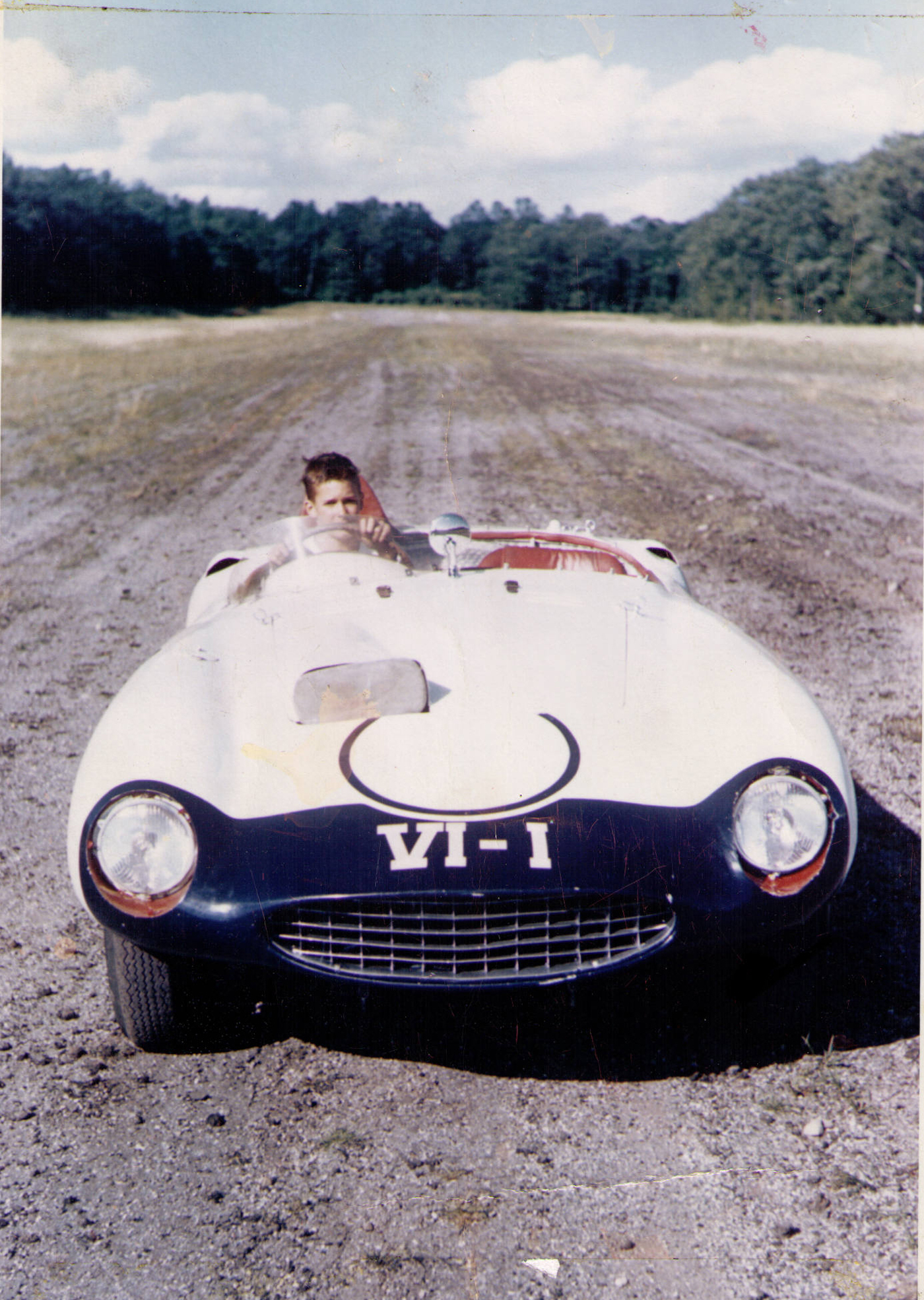
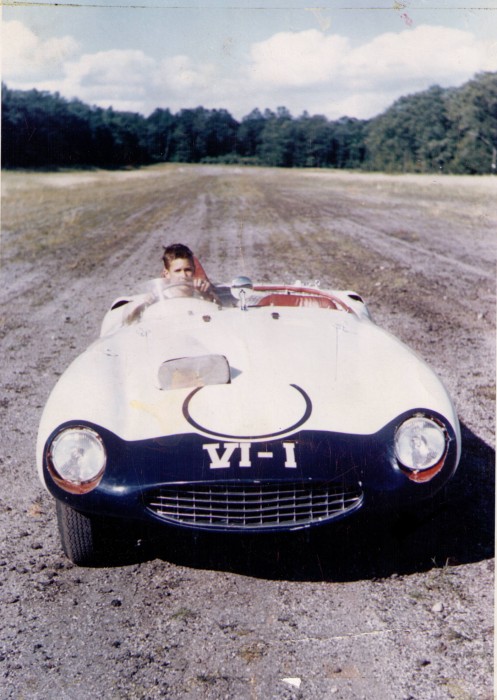
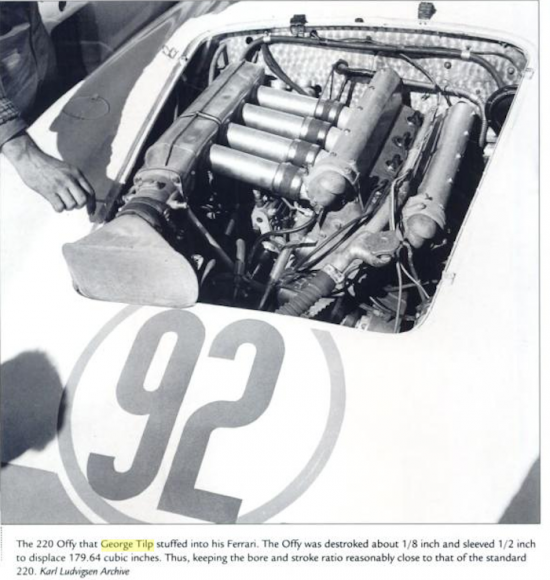
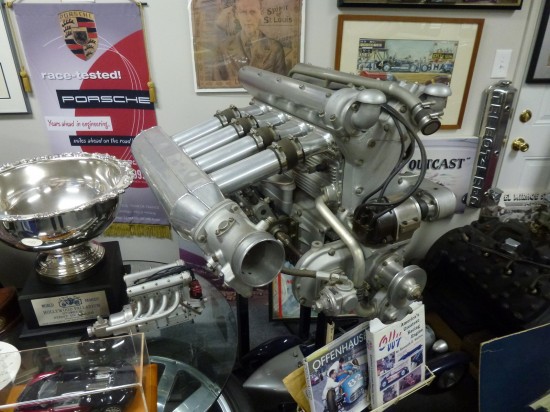
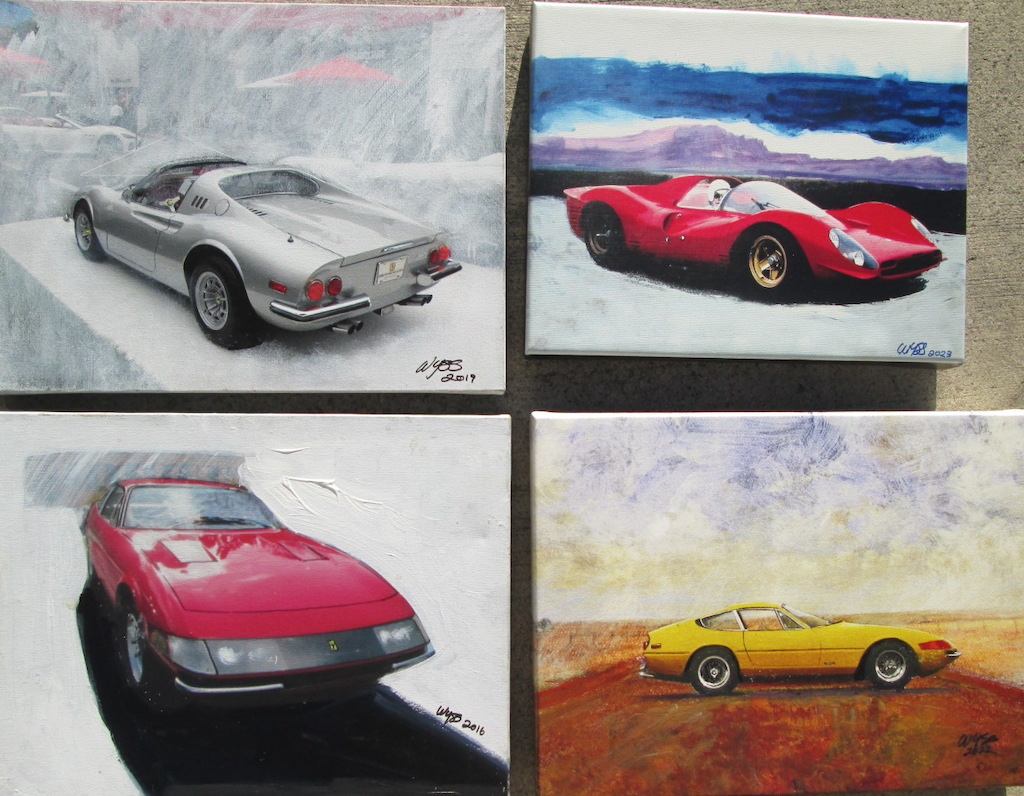

Well, where do you start on this one? So many facts, so much of interest, what a great story, what a
great period.
Would like to know if anyone has an update on the “missing” library and the car collection and maybe getting the 16mm film on to You Tube or??
Is there a more extensive history anywhere on George Tilp, I would really like to get more him and the period?
Thanks for bringing this to my attention.
CJ
Ciaran,
As far as I know this is the most history about George Tilp published anywhere.
Mike,
1. The 500 Mondial, ex-Rubirosa, ex-Pauley is 0464MD
2. It used to be be with Mr. Ulrich in Switzerland from 1963 until around 1993 when he sold it to Mr. Siemes in Germany, apparently it’s present owner.
Best regards,
Antoine Prunet
With reference to the oil pick-up situation with the Offy engine at the “Formula Libre” event in 1958, reminds me of a similar situation with Mario Andretti’s car at the inaugural Indy race at Mr. Fuji speedway, Japan in the fall of 1966. Even though the organizers reversed the course direction, there was still a right hand turn that repeatedly knocked out Mario’s engine bearings. I recall the team was on the telephone trying all over Japan for replacement bearings, of no avail. I believe Graham Hill, whose car had oil pick-ups on both sides of the crankcase, won the race. Since that was over 45 years ago, I can be corrected on this. But I was one of the few English speakers there and was listening carefully.
Oil starvation is an understandable issue, especially with a dry sump if not given multi stage pumps and pickups, and if the accumulator tank is not properly tested in racing conditions. Some of the pickups are always sucking air and the accumulator has to de-aerate the oil before returning it to the engine. The Cunningham C6 at LeMans was apparently afflicted with no such issue as it lasted many hours, although poor grade fuel and some transmission or clutch issue eventually shortened its race.
I used to work for Adams Industries, the stamping plant owned by George Tilp, back in 1976. My sole duties were taking care of George’s garage full of vintage automobiles and a restored Pullman Car named “Lotus Club” out on a stretch of track on the front lawn of the factory. I remember driving George’s 300 SEL — that thing was a rocket on wheels! He explained to me that it was the fastest production car made up till that time. His vintage car collection, at that time, consisted of a 1945 Navy Jeep (5000 original miles) which was restored over into an Army Jeep.
He also had a 1917 Packard Town Car with a twin-six engine (two six cylinder engines hooked to a common crankshaft). This was a car was restored to 99/100 point condition. The only item out of place was the angle of the exhaust pipe (off a few degrees). What a terror it was to start — you had to pump and pump a hand lever near the drive shaft tunnel in order to work up 3 psi. of pressure — which forced the gasoline to flow from the tank in the rear toward the carburetor.
http://www.conceptcarz.com/view/photo/799262,20773/1917-Packard-Twin-Six_photo.aspx
There was a 1937 Cadillac Limousine with a V-16 engine (that gave George no end of trouble — the updraft carburetors would suddenly kick out and you found yourself driving on only 8 cylinders!).
http://www.newcadillacdatabase.org/static/CDB/Dbas_txt/V6srv34.htm
Then, there was a 1939 Packard with a V-12 engine — beautifully restored, but subject to cylinder head leaks (aluminum head – cast iron block…..not good bed fellows).
http://www.conceptcarz.com/images/Packard/39_Packard-12-Touring-DV-13-RMSJ_01.jpg
George also owned a 1966 Cadillac Sedan Deville in very good condition. I don’t believe it was restored — just kept in immaculate shape through the years.
I remember George, from an employer/employee standpoint as being a stern, but fair man. I could sense in him an inner strength, held in reserve. Personally, I liked him and respected him very much. God bless his soul!
My chief responsibility was maintaining the automobiles in George’s classic collection. I would change the oil on each car regularly, make sure the batteries were charged, and do simple repairs like fixing the power assist on the 1937 Packard’s brakes. I used to love working in that garage/office! Unfortunately, I had no idea of the history that happened in that very space that I occupied.
Just an anecdote that I remember fondly. One day John Abruzzo ask me to change the oil on his Porsche. He warned me that it was a dry sump engine and that it held 11 quarts of oil…… That when I pulled the plug only a quart or two would pour out, and then I would have to drain the main tank of oil stored in the rear quarter panel. He told me to get several large oil drip pans to do the job. So I pulled the plug on the oil pan and only little oil came out. Then I went to drain the main oil tank under the quarter panel…… And the oil kept coming…… And coming….. And coming! Good grief!! It overflowed the oil drip pan and went all over the garage floor! Needless to say — that experience instilled some instant humility in me that day!
And I remember seeing the offenhauser engine sitting on a display stand outside the glass doors of George Tilp’s office. I think he had a groomed — it was all bright and shiny and clean. I had no idea of the history of that engine. Peter Tilp, my boss, just told me that his dad used to race cars back in the 1950s and that he used this engine.
My heart broke when I heard that Peter had passed away. I knew him well and I found him to be a “gentleman of the first water”. He always holds a special place in my heart!
Hi John, my name is Ralf Feldhues and I would like to know more about the race season 1955/56 regarding the Tilp team. Perhaps you can put me in touch with someone or even know yourself who has records or documentation or personal knowledge from this period. I am particular interested in the use of the 300SL Gullwing in these two years. I know that in these two seasons, not just one 300SL was used by the Tilp team. In this context, I try to complete the history of two 300SL Gullwing carsthat were used during this time.
I would be very grateful for an answer.
With kind regards
Ralf Feldhues
On those Mercedes 300SLs, called SLS, it is my theory that the frames or body or both were magnesium and MB didn’t want that discovered so after the winning season they had them destroyed. Why would they hide that when the first one was run as a prototype and thus didn’t have to be like the production car. Why was magnesium a bad word? LeMans ’55. When that magnesium-bodied Mercedes 300SLR went into the stands the fire crew found out magnesium is a metal that burns and water won’t put the fire out.
A story on a site called Psychoontires says “Despite sending George Tilp two cars, two Mercedes Benz race mechanics, Erwin Strupp and Karl Bunz with a container load of spares, the plan was to run only one car to give the operation the semblance of a privateer effort, however after Paul crashed one car at Thompson Connecticut and turned up six days later with an apparently completely repaired car at Elkhart Lake in Wisconsin the cat was out of the bag that George Tilp had two cars at his disposal for Paul”.
The Offy motor lives in Ron Kellogg’s living room in Whittier, California.
Ron Cummings
You can read more and see more photos at this link:
https://mycarquest.com/2014/01/for-sale-the-most-stately-offenhauser-engine-the-george-tilp-offy-once-owned-by-phil-hill.html
I smiled when I read about the vibrations upsetting the carbs. Ferrari’s solution was to bolt the carbs to part of the frame structure, and use flexible intake manifolds. If I recall, this was featured on the 500 Mondial.
One of the best stories yet on My Car Quest!
All george TILP’s possesions went from his 2nd wife Judy to Adeline Hubener (Toms River area)
Hi,
Did you know them well? Judy was my great aunt on my moms side.
Marisa……contact me @ docrob1951@yahoo.com for all the family stories
I am glad you enjoyed my article about my Uncle George Tilp. I asked my cousin John Abruzzo who worked for his Uncle to put George’s life to paper. George’s son Peter Tilp ended up with half of all the films, documents and trophies. Sadly Peter passed away I think around 2016. The location of his storage room passed with him.
Bobby Tilp sent me a 16mm film one hour of George and Phil Hill at Road America Sept 11, 1955. I spent 10 years editing it and it can be seen on Vimeo.com Search Phil Hill Road America 1955
Cheers,
Geoffrey Horton
Thank you for that film. My grandfather was Joe Roder, who can be seen at several points doing the build and at the race. That is incredible to see him “in his element”.
I’ve included a picture with him and your Uncle George in front of the Schnelltransport with the 300SL and the station wagon with the Airstream trailer.
Hi Ken,
What a small world. I am so glad you enjoyed the video of George, Phil and Paul O’Shea along with all the help support. We can now add Joe Roder to the list. I often wondered who he was. Your attached photo is timeless and most appreciated.
This was an Era of racing can not be forgotten. Going forward, I would love to add your photo to my video.
Maybe you could reach out to Mike Gulett for my contact information. I would love to talk to you and maybe share more stories and photos if possible.
Thanks for posting and reaching out.
Cheers
Geoffrey
Want to thank Mike Gulett for posting the original article and keeping it alive on the Internet.
Geoffrey
As a child growing up in Short Hills, NJ, close to the Tilps, I was fortunate to have spent time with the Tilps, especially at “The Farm” as we all called it. It wasn’t a farm; there were no crops or animals and George did not live there. Yes, people were invited to drive race cars on the airstrip. The 1st time I drove a car was at about age 8 on my dad’s lap at The Farm but it was our family’s station wagon, not a race car. It was also the 1st time I got drunk, on my 8th birthday because adults thought it was cute to give me liquor. My parents were worried I would drown in the pool. George and his wife Thelma hosted multiple guests on summer weekends and the adults enjoyed the free-flowing booze and delicious food staff would prepare and serve in “The Steakhouse” whose walls were lined with beer steins. Jonny Abruzzo and his sisters and parents were very kind to us, the Terraces, as were the Tilps and the whole crew who took turns having small parties at each our homes. That group sure knew how to drink and eat and LAUGH.
Christine those were great memories to cherish.
The Tilp Farm was a special place.
Thanks for sharing.
Geoffrey
I remember the same thing as Christine! Food and drink and cars. Driving the cars, including the Ferrari (2-seater) on the airfield. Peter Tilp, who was my age, was the driver. George and my stepfather were cousins. I remember Phill Hill relaxing in a hammock that was alongside the “steakhouse.” I recall a beautiful restored antique vehicle, possibly a Cadillac, vintage possibly 1924, that Peter, and maybe also Johnny Abruzzo, drove around the airfield.
I have some old home movies that were taken by my stepfather, George’s cousin, at a race in Sebring Florida in the 1950s. There is a brief glimpse of another racing friend that I recall was named the count they portago in this film.
Patricia, I talked with Peter a month before he passed away. All his photos and films from the 50’s were lost in his storage room. Those were cherished times.
G
I get that. I was simply saying that *I* have home movies made by my father, George’s cousin, that have some racing activities and Tilp folks at Sebring in the movie.
And I also had contact with Peter in the year before he passed away. He often talked about going out to “his warehouse in New Jersey” to get some collectible to put up for sale to create income. I had the feeling that the contents of said warehouse were long gone, but he liked making me think they existed. *Sigh.*
It would be nice to see that film on a private web site like I did with Uncle Bob’s racing video of George and Phil.
G
George was a great guy……..too bad he got “tied” up with his telephone operator/receptionist my aunt JUDY “TILP”….(seven previous marriages)
She shut him down and destroyed his enjoyment in the motorsports world. I spent time with “uncle” George talking porsches/benz and he admitted he was a broken
man after his marriage to Judy…..
And unfortunately, Rob, that’s what destroyed the relationship between George and Peter. Peter loved his mother very much, but he deeply resented his dad’s remarriage to the company secretary.
But I can see things from George’s perspective also. He was probably very lonely at that point….. And perhaps very vulnerable (maybe for the first time in his life). He might have just been a lonely man reaching out to not feel so lonely anymore. Your thinking isn’t always so clear and discerning in that kind of a circumstance. It’s a shame that it didn’t work out.
totally understood……I spent maybe 15 days with GT (post wedding) over the rest of his lifespan……knew him prior to his remarriage/ disposed of the drugs for him from his wife’s health problems and tried to talk him out of “buying off”
Peter.
I met Phil Hill @ GT’s funeral, talked motorsports for a few minutes only to be shocked by husband # 4&6 (same person) to wander into the funeral home, then take up residence @ the hartshorn abode.
Only met PT some 6-8 times in my highschool & pre-med years in maplewood……talked trains/ rode some from Maplewood center.
Secretary is a very kind description……..she wielded GT’s $$$ with an iron fist & forced many of our family members to bow @ her whim……fortunately I was NOT a pawn, and did not receive any of the inheritence.
I had removed myself from the relationship many years before Judy died and she left the inheritance to Adeline Hubener & Robbin Hartman.
Honestly, I have NOT thought about “aunt Judy” for a very long time prior to this last blog…….@ 73 y.o. life goes on and is still pretty darn good.
I guess when you’re as affluent as George Tilp was you become an easy target for whatever gold diggers come along.
In the end…… We all have to meet Our Maker….. And answer for what we did with our lives. I hope she reforms her ways before it’s too late.
By the way…..Peter Tilp’s collection of memorabilia may not be lost “forever”. When I was working for him he used to host weekend parties on the Lotus Club Pullman car sitting on the front lawn of the Adams industries property. Peter would have me pick up the original Pullman porters, waiters, and Cooks (old retired gentlemen) to serve on the car once again. And he would invite many of his fellow railroad enthusiasts who also owned Pullman cars to spend the weekend on the car.
These guys would all bring their scrapbooks and their stories and their memories and swap all this information with each other. They knew about each other’s families, family histories, and other “goings on” that was not public information.
I’ll bet if you made an effort to locate some of these Pullman car buddies of Peter’s — those who would still be alive — you just might be able to secure the information about the location of the warehouse where Peter’s memorabilia is stored. It’s worth a try.